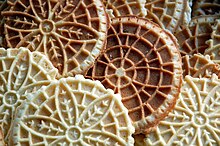 | |
| Course | Dessert |
|---|---|
| Place of origin | Italy |
| Region or state | Abruzzo |
| Main ingredients | Flour, butter/oil, sugar |
Pizzelle (Italian: [pitˈtsɛlle]; sg.: pizzella) are traditional Italian waffle cookies made from flour, eggs, sugar, butter or vegetable oil, and flavoring (usually anise or anisette, less commonly vanilla or lemon zest). They can be hard and crisp or soft and chewy[citation needed] depending on the ingredients and method of preparation. Pizzelle can be molded into various shapes, including in the tubular shape of cannoli.
Pizzelle were originally made in the comune (municipality) of Ortona, in the Abruzzo region of Italy. Many other cultures have developed a pizzelle-type cookie as part of their culture (for example, the Norwegian krumkake). It is known to be one of the oldest cookies and is probably to have developed from the ancient Roman crustulum.[1]
Pizzelle are also known as ferratelle or nevole in some parts of Abruzzo,[2] as ferratelle in Lazio, and as ferratelle, cancelle, or pizzelle in Molise.[1] Additionally, pizzelle are known locally as tie plates in Sault Ste. Marie, Ontario.[3]
The cookie dough or batter is put into a pizzelle iron, which resembles a small variant of the popular waffle iron.[4] Originally, the long-handled pizzelle iron was held by hand over a hot burner on the stovetop, although today most pizzelle are made using electric models and require no stove.[5] Typically, the iron stamps a snowflake pattern onto both sides of the thin golden-brown cookie, which has a crisp texture once cooled, though some pizzelle irons feature family crests, special dates, or other decorative designs.[6] Store-bought pizzelle are now commonly available in Italy, and other areas with a large Italian population.

Pizzelle are popular during Christmas and Easter.[2] They are often found at Italian weddings, alongside other traditional pastries such as cannoli and traditional Italian cookies.
It is also common to sandwich two pizzelle with cannoli cream (ricotta blended with sugar) or hazelnut spread. Pizzelle, while still warm, can also be rolled into a tubular shape using a wooden dowel to create cannoli shells.